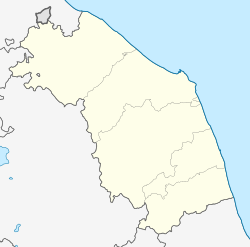Jesi | |
|---|---|
| Città di Jesi City of Jesi | |
 | |
| Coordinates: 43°31′25″N 13°14′21″E / 43.52361°N 13.23917°E | |
| Country | Italy |
| Region | Marche |
| Province | Ancona (AN) |
| Frazioni | Mazzangrugno, Castelrosino, Tabano, Santa Lucia |
| Government | |
| • Mayor | Lorenzo Fiordelmondo (PD; left) |
| Area | |
| • Total | 107 km2 (41 sq mi) |
| Elevation | 97 m (318 ft) |
| Population (31 August 2017)[2] | |
| • Total | 40,251 |
| • Density | 380/km2 (970/sq mi) |
| Demonym | Jesini |
| Time zone | UTC+1 (CET) |
| • Summer (DST) | UTC+2 (CEST) |
| Postal code | 60035 |
| Dialing code | 0731 |
| Patron saint | Saint Septimius |
| Saint day | September 22 |
| Website | comune.jesi.an.it/IlComune/[1] |

Jesi (Italian: [ˈjɛːzi]) is a comune (municipality) in the province of Ancona, in the Italian region of Marche.




It is an important industrial and artistic center in the floodplain on the left (north) bank of the Esino river, 17 kilometres (11 mi) before its mouth on the Adriatic Sea.



